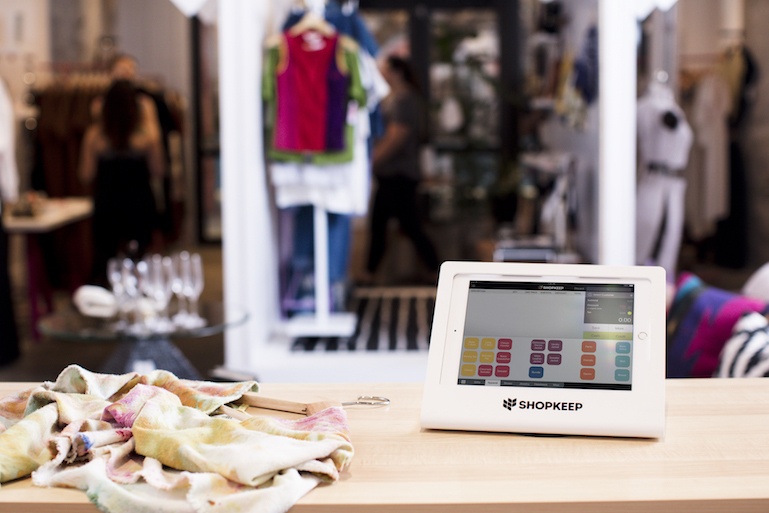
What is the Best POS System For a Small Business?
As a small business owner, choosing the best POS system is a necessary ingredient in the recipe for success.
Whether you run a retail shop, bakery, coffee shop, restaurant, or bar, success is hard to come by. With more prominent brands and established competitors around each corner, you need every advantage available to get ahead. If you aren’t using a point of sale (POS) system, then you’re neglecting a critical tool that can give you a competitive edge.
That said, we understand that point of sale systems can be confusing, especially if you’re used to traditional tools like the trusty electronic cash register. In this article we’ll help you understand how to POS systems work, so you can answer the question, “What is the best POS system for small business?”
What is a POS System?
Before we dive into the specific features that make a particular POS system the best choice for a small business, it’s crucial that we all get on the same page. A POS system is a combination of software and hardware. Its primary function is to allow merchants to accept payments from customers.
What separates a POS from a simple cash register are the wide variety of additional capabilities that a POS offers. We’ll go into these in greater detail shortly, but for now, it’s essential to know that a point of sale system will help you with reporting, inventory management, employee management, and marketing, and more.
The key, then, to choosing the right POS system is understanding how each of these features works so you can appropriately weigh the tradeoffs between systems. No solution is perfect or offers everything you’ll ever need. But you can get pretty close.
Cloud vs. On-Premise
We’ve written about this in the past, so we won’t go into a highly detailed comparison of on-premise POS systems vs. cloud POS systems. Suffice to say, there’s no reason for a small business to go with an on-premise solution. The cost and lack of flexibility just don’t hold up when you compare them to the benefits of the cloud:
Affordability
You almost always pay for a cloud POS software with a monthly subscription fee, similar to Netflix or other business software you might already be using like Quickbooks or MailChimp. Some vendors may offer discounts if you agree to annual contracts, and others may take a cut of your payment processing to pay for the software. Whatever the specifics, you’ll almost always end up paying less by going with a cloud POS system.
Free Upgrades
Just like with your phone and computer, upgrading or updating your POS software with new versions is an essential part of your long term success. Not only do new software versions typically include new features and bug fixes, which can help you boost sales and efficiency, but they often also include security patches.
Using a POS system means dealing with sensitive customer data, so staying up to date from a security perspective is essential, especially when it’s as easy as updating your POS software. Did we mention that unlike with on-premise software, updating cloud POS software is as simple as updating an app on your phone?
Easy to Use
Cloud-based software is new software, and that means it’s easy to use, especially when you compare it against on-premise software that may have been first built in the late 1990s. As a small business owner, your time is in short supply. You don’t have a surplus of available time in your schedule to figure out complicated software. You need something that works out of the box. Using something cloud-based is often the best way to guarantee that’s the case.
Reliable Hardware
Cloud POS software typically runs on commonly available hardware like Android tablets or iPads. Some variations may also run on a laptop or desktop computer. The key is that this hardware is usually something you can go to the store and buy yourself or order off of Amazon.
Not only does this make it easier to get a replacement if something breaks or if you just want an upgrade, but the hardware is also typically less expensive than the proprietary hardware used by on-premise systems.
Essential Features of Small Business POS Software
At this point, it should be clear that the benefits of cloud POS systems make them close to perfect for small business owners. With that out of the way, it’s time to look at the key features of a cloud POS system, while highlighting the specific criteria that small business owners should look out for. While there are differences in the specific needs of retail and restaurant POS owners, this overview will work to strike a balance between each.
Reporting and Analytics
One of the primary features and key reasons to use a POS system are the reporting and analytics capabilities. These tools help you understand what’s going on with your business so that you can make informed decisions that help you grow and operate more efficiently. Unfortunately, comparing the reporting and analytics tools of POS systems against one another can too often devolve into a highly technical discussion. To help curb that, we’re going to focus less on specific features and more on the qualities you’ll want your reporting tools to have.
SEE ALSO: Everything You Need to Know About In-Store Retail Analytics
Comprehensive
Moving from one POS system to another is a complex and lengthy process. You want to ensure you get it right the first time. As part of that, make sure that your reporting tools offer all of the reports that you think you’ll need. Consider the future in this evaluation. You may not have staff right now, but you might in the future, so those employee performance reports collecting dust today, could turn into one of your most valued assets.
Easy to Use
Reporting and analytics tools can get confusing quickly. It’s a complicated subject to begin with, and not every vendor implements them with beginners in mind. Even if you’re an analytical expert, it’s likely that your business partner or one of your employees isn’t. You want tools that will be easy to adopt by most of your employees, otherwise, they’re kind of useless. So, be sure to see a demo or sign up for a free trial to test drive the analytics tools for yourself. If possible, let employees use them too so they can weigh in.
Flexible
In analytics and reporting, there’s this concept of “exploring data.” This means moving beyond what a report shows you by default to dig another layer deeper. To ensure your tools have the most utility, you’ll want them to display this kind of flexibility. This means you should be able to easily compare different metrics against one another, look at performance between different date ranges, or export your data into a spreadsheet where you can perform more sophisticated analyses.
Real-Time Reporting
Lastly, you’ll want to ensure that your reporting tools give you access to real-time data. For example, real-time inventory data will show you stock levels at-a-glance. If this data is delayed, you run the risk of selling an item you don’t have in stock or preparing a dish that’s missing an ingredient. Neither situation is a recipe for great customer service.
Inventory Management
Another significant feature of both retail and restaurant POS systems is inventory management. Similar to reporting and analytics, it’s easy for inventory management to get complicated quickly. It’s an area of your business where a small error can quickly compound, creating significant headaches down the line. That’s why it’s so essential to pick a POS solution with tools that match both your needs and level of experience.
Ease of Use
Simple tools prevent errors and help you speed through your workday. Receiving inventory, setting up reorder triggers, and performing spot checks run the risk of becoming tedious, fast. Easy to use tools help you stay focused and complete these tasks quickly so you can get back to the things you enjoy about running a retail store or hospitality business.
Time-Saving and Organizational Tools
Particularly in the restaurant business, where the clock is always ticking, you need inventory management tools that help you stay organized and save time. Specifically, you’ll want to look out for features like:
- Reorder Triggers – These are low stock notifications that let you know when it’s time to order more of a specific product or ingredient.
- Bulk Management – Instead of updating quantities for each item individually when you receive an order, this feature lets you make updates for an entire order with a spreadsheet. This is also a great feature for situations where you’re adding multiple new items, dishes, drinks, etc. to your inventory and want to take care of it at once.
Tracking Your Value
Some of the biggest pitfalls that small business owners run into are not properly understanding the value of their inventory or tying up too much cash in inventory. Both of these issues result in cash flow problems that can cause serious trouble if not quickly corrected. The best way to prevent this from happening is with inventory management tools that accurately track the cost and value of your inventory.
This helps you understand how much you have invested in inventory, while also tracking profit margins. Margins are particularly important to understand and monitor because they reflect your overall profitability, which is an excellent proxy for the financial health of your business.
SEE ALSO: How to Be a Food and Beverage Cost Control Ninja
Marketing
Smart hospitality and retail businesses know the importance of marketing, and they bake it into everything they do. Fortunately, POS systems can facilitate marketing through several key capabilities.
Tools that Generate Repeat Business
It’s an old truism that it’s always cheaper to retain a customer than acquire a new one. For cash-strapped small businesses, this is often the avenue to sustainability. Make sure that the POS systems you’re evaluating include tools like loyalty programs and email marketing integrations to help you turn first-time shoppers into loyal customers.

Tools to Reach New Customers
While not as common, it can give you a serious advantage if your POS system includes tools that can help you reach new customers. For example, ShopKeep’s restaurant POS and retail POS both include a tool called ShopKeep Spotlight. Without going into too many details, ShopKeep Spotlight helps you manage customer reviews, as well as local search engine optimization (SEO).
Closely monitoring and managing these areas of your business is one of the best ways for small businesses to reach new customers. The idea is to appear at the top of Google for searches about your type of business, to have compelling listings on tools like Facebook or Foursquare, and have positive reviews on key platforms like Yelp. In doing so, you make your business look like the right choice when potential customers are searching for the products and services you offer.
Integrations
It’s unlikely that your POS system is the only piece of software you’re using to run your business. Your point of sale will offer you even more utility if it integrates with the third-party software you use today, as well as the tools you plan to use in the future.
For example, an integration with an accounting tool like Quickbooks can automatically import the day’s sales data from your POS to Quickbooks for more accurate reporting. Similarly, integrating with an ecommerce platform like BigCommerce can keep your inventory in sync between online and in-store sales. If you run a restaurant, then an online ordering service is an integration to consider.
Payment Processing Hardware
When searching for the best POS system for your small business, you’ll want to make sure you find one that can meet your payment processing needs. We won’t go into the specifics of work with a merchant services provider now, but we will talk about POS hardware. The key here is to find a system that supports the types of payments you want to accept.
For the sake of this article, we’ll assume you want to accept all of the tried-and-true payment methods, as well as the latest-and-greatest. That means you’ll want support for:
- Credit Card Reader – Your reader should be able to take credit card payments, debit cards, EMV chip cards, and contactless payments like Apple Pay.
- Receipt Printer – While many merchants are switching to email-only receipts there are still many shoppers that prefer a paper receipt. In restaurants, most shoppers expect to tip and sign a paper receipt, so you’ll want to account for that experience if it makes sense for your business.
- Barcode Scanner – Specifically for retail businesses, merchants use a barcode scanner to scan items to add them to an order when ringing up customers. Often this is much faster than manually adding items to an order, improving the customer experience.
Recommended POS Solutions
Now that you have a solid understanding of the various criteria that define the best POS system for small business, the next step is to look at options that fit the mold.
ShopKeep
ShopKeep is rated as the #1 tablet POS system by Trustpilot, an independent, leading source of software reviews. It works for retail and quick-service businesses, as well as restaurants and bars. Designed for growing small businesses, ShopKeep features powerful but easy-to-use tools that help merchants and restaurateurs run more efficient and profitable businesses.
ShopKeep runs on iPads and Android tablets and uses cloud technology to remain affordable and easy to use, without skimping on power. With support for all major payment methods, ShopKeep ensures that your customer will always have an easy way to pay.
Square
Square is a popular mobile POS that started as a simple way to accept credit card transactions. You’ve likely seen their white card reader dongle that connects to smartphones. From there, Square has built out more fully featured POS software for retail businesses and restaurants.
There are two big knocks on Square. The first is that their software is on the basic side of things. If you are an established, growing business then you will likely run into limitations that hurt your business’ ability to reach its full potential.
Second, Square’s primary business model is selling you their payment processing. Their “free POS software” is just a tool to do that. This isn’t inherently wrong except that merchants can often save significant money by moving to a processor that uses interchange-plus pricing (like ShopKeep) versus Square’s flat rate. Their customer support is often criticized in online reviews as well.
As we hope this article demonstrates, picking the right POS system is a matter of understanding your unique needs and then finding a solution that addresses them at a price point you can afford. Perhaps most importantly, you want to ensure you select a POS that you can see yourself using day-in and day-out for at least a few years. Moving from one system to another is a complex and time-consuming process that can interrupt your ability to do business. Picking a solution you can grow into often makes the most sense in the long run.
Want to try ShopKeep for yourself?
Just answer a few easy questions.
Need help finding the right point of sale?
Just complete the form. We’ll call you right back to explain how ShopKeep can work for you.
Hit the ground running.Sprinting, in fact!
Read our free, comprehensive guide, Small Business 101, to learn all you need to know about starting a thriving business.

